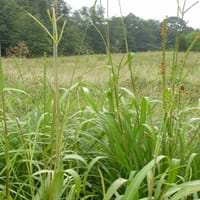Life Span
Perennial
Perennial
Type
Grass
Flowering Plants, Shrubs
Origin
United States, Northeastern United States, Mid-Atlantic United States, Southeastern United States, Central United States, South-Central United States, Texas, Mexico, Caribbean
Africa, America, Asia
Types
Not Available
Lockinch, Petite Indigo, White Profusion
Number of Varieties
Not Available
Habitat
marshes, Riverbanks, Sandy areas, Tropical rainforest
Along Railroads, River side, Roadsides
USDA Hardiness Zone
5-10
5-10
Sunset Zone
Not Available
H1, 2a, 2b, 3a, 3b, 4, 5, 6, 7, 8, 9, 10, 11, 12, 13, 14, 15, 16, 17, 18, 19, 20, 21, 22, 23, 24
Habit
Clump-Forming
Arching/Fountain-shaped
Flower Color
Light Yellow, Orange Red
Blue, Pink, Purple, Red, White
Flower Color Modifier
Bicolor
Not Available
Fruit Color
Light brown, Light Green
Not Available
Leaf Color in Spring
Green, Olive
Gray Green
Leaf Color in Summer
Light Green
Gray Green, Light Green
Leaf Color in Fall
Red, Dark Green, Dark Red, Bronze
Gray Green, Light Green, Yellow green
Leaf Color in Winter
Light Green
Not Available
Leaf Shape
Long Linear
Egg-shaped
Plant Season
Summer, Fall, Winter
Fall, Spring, Summer, Winter
Sunlight
Full Sun, Partial Sun
Full Sun, Part sun, Partial shade
Type of Soil
Clay, Loam, Sand
Loamy, Sandy, Well drained
The pH of Soil
Acidic, Neutral, Alkaline
Neutral, Slightly Acidic, Slightly Alkaline
Soil Drainage
Average
Well drained
Bloom Time
Late Spring, Early Summer, Summer, Late Summer
Spring
Tolerances
Wet Site, Drought
Drought, Pollution, Salt, Soil Compaction
Where to Plant?
Container, Ground
Ground, Pot
How to Plant?
Seedlings
Seedlings, Stem Planting, Transplanting
Plant Maintenance
Medium
Medium
Watering Requirements
Requires consistently moist soil, Requires regular watering, Water daily during growing season
Form a Soil ring to water efficiently, Water Deeply, Water twice a day in the initial period
In Summer
Lots of watering
Lots of watering
In Spring
Moderate
Moderate
In Winter
Average Water
Average Water
Soil pH
Acidic, Neutral, Alkaline
Neutral, Slightly Acidic, Slightly Alkaline
Soil Type
Clay, Loam, Sand
Loamy, Sandy, Well drained
Soil Drainage Capacity
Average
Well drained
Sun Exposure
Full Sun, Partial Sun
Full Sun, Part sun, Partial shade
Pruning
Remove damaged leaves, Remove dead branches, Remove dead leaves
Cut or pinch the stems, Prune for shortening long shoots, Prune if you want to improve plant shape, Prune ocassionally, Remove damaged leaves, Remove dead or diseased plant parts, Remove deadheads, Remove shoots
Fertilizers
Nitrogen, Phosphorous, Potassium
All-Purpose Liquid Fertilizer
Pests and Diseases
Borers, Red blotch
Downy mildew, Leaf spot, Spider mites
Plant Tolerance
Drought
Drought
Flower Petal Number
Single
Single
Foliage Texture
Coarse
Medium
Foliage Sheen
Matte
Matte
Invasive
Sometimes
Sometimes
Attracts
Insects
Butterflies, Hummingbirds
Allergy
Skin irritation
Vomiting
Aesthetic Uses
Landscape Designing
Showy Purposes
Beauty Benefits
No Beauty Benefits
Not Available
Environmental Uses
Air purification
Air purification
Medicinal Uses
No Medicinal Use
Not Available
Part of Plant Used
Leaves
Flowers, Leaves
Other Uses
Animal Feed, Decoration Purposes, Showy Purposes
Showy Purposes, Used as Ornamental plant
Used As Indoor Plant
No
No
Used As Outdoor Plant
Yes
Yes
Garden Design
Groundcover, Mixed Border, Water Gardens, Wildflower
Edging, Feature Plant, Foundation
Botanical Name
TRIPSACUM dactyloides
Buddleia davidii
Common Name
Eastern Gamagrass
Butterfly Bush, Summer Lilac, Butterflybush
In Hindi
पूर्वी Gamagrass
Butterfly Bush
In German
Eastern Gamagrass
Schmetterlingsstrauch
In French
Gamagrass Orient
buisson de papillon
In Spanish
Maicillo del Este
arbusto de las mariposas
In Greek
Ανατολική Gamagrass
Butterfly Μπους
In Portuguese
Gamagrass Oriental
arbusto de borboleta
In Polish
Eastern Gamagrass
Butterfly Bush
In Latin
Orientalium Gamagrass
papilio rubo
Phylum
Streptophyta
Spermatophyta
Class
Liliopsida
Dicotyledonae
Family
Poaceae
Scrophulariaceae
Clade
Angiosperms, Commelinids, Monocots
Angiosperms, Asterids, Eudicots
Tribe
Andropogoneae
Not Available
Subfamily
Panicoideae
Not Available
Number of Species
Not Available
Season and Care of Eastern Gamagrass and Butterfly Bush
Season and care of Eastern Gamagrass and Butterfly Bush is important to know. While considering everything about Eastern Gamagrass and Butterfly Bush Care, growing season is an essential factor. Eastern Gamagrass season is Summer, Fall and Winter and Butterfly Bush season is Summer, Fall and Winter. The type of soil for Eastern Gamagrass is Clay, Loam, Sand and for Butterfly Bush is Loamy, Sandy, Well drained while the PH of soil for Eastern Gamagrass is Acidic, Neutral, Alkaline and for Butterfly Bush is Neutral, Slightly Acidic, Slightly Alkaline.
Eastern Gamagrass and Butterfly Bush Physical Information
Eastern Gamagrass and Butterfly Bush physical information is very important for comparison. Eastern Gamagrass height is 150.00 cm and width 90.00 cm whereas Butterfly Bush height is 7.50 cm and width 4.00 cm. The color specification of Eastern Gamagrass and Butterfly Bush are as follows:
Eastern Gamagrass flower color: Light Yellow and Orange Red
Eastern Gamagrass leaf color: Green and Olive
Butterfly Bush flower color: Blue, Pink, Purple, Red and White
- Butterfly Bush leaf color: Gray Green
Care of Eastern Gamagrass and Butterfly Bush
Care of Eastern Gamagrass and Butterfly Bush include pruning, fertilizers, watering etc. Eastern Gamagrass pruning is done Remove damaged leaves, Remove dead branches and Remove dead leaves and Butterfly Bush pruning is done Cut or pinch the stems, Prune for shortening long shoots, Prune if you want to improve plant shape, Prune ocassionally, Remove damaged leaves, Remove dead or diseased plant parts, Remove deadheads and Remove shoots. In summer Eastern Gamagrass needs Lots of watering and in winter, it needs Average Water. Whereas, in summer Butterfly Bush needs Lots of watering and in winter, it needs Average Water.



